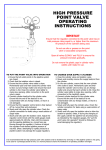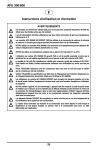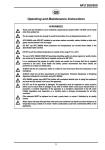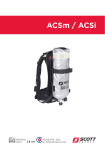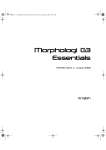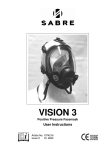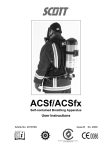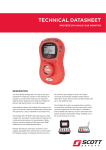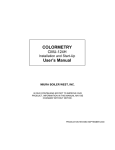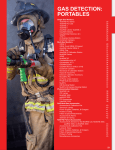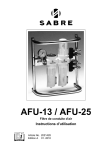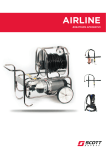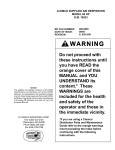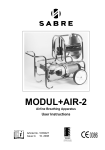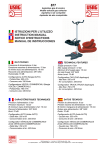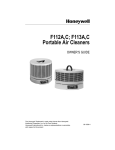Download AFU 13 / AFU 25 User Manual in English
Transcript
AFU-13 / AFU-25 Airline Filter Unit User Instructions Article No. 1034951 11. 2004 Issue B AFU-13 / AFU-25 Airline Filter Unit Contents WARNINGS............................................................................................................................... ii 1. INTRODUCTION ............................................................................................................ 1 1.1 BREATHABLE AIR.................................................................................................. 1 1.2 SUPPLY PRESSURE AND FLOW - DEMAND VALVE-FED.................................. 1 1.3 SUPPLY PRESSURE AND FLOW - CONSTANT FLOW ....................................... 1 1.4 PERSONNEL TRAINING ........................................................................................ 2 1.5 SERVICING............................................................................................................. 2 2. TECHNICAL DESCRIPTION.......................................................................................... 2 3. INSTALLATION AND OPERATING PROCEDURE....................................................... 3 3.1 CHECK COMPRESSOR / SUPPLY........................................................................ 3 3.2 PURGE AIR............................................................................................................. 3 3.3 CHECK HOSES ...................................................................................................... 3 3.4 CHECK APPARATUS ............................................................................................. 3 3.5 CONNECT SUPPLY................................................................................................ 4 3.6 CHECK SUPPLY PRESSURE AND FLOW ............................................................ 4 4. SHUTTING DOWN PROCEDURE ................................................................................. 4 4.1 REMOVE BREATHING APPARATUS .................................................................... 4 4.2 ISOLATE / BLEED SUPPLY ................................................................................... 4 4.3 DISCONNECT HOSES / EQUIPMENT................................................................... 4 4.4 CLEAN, EXAMINE AND TEST EQUIPMENT ......................................................... 4 4.5 RECORD DETAILS OF USE................................................................................... 4 5. CHECK AFU................................................................................................................... 5 5.1 CHECK SIGHT GLASS ........................................................................................... 5 5.2 CHECK VENTS ....................................................................................................... 5 5.3 CHECK HOUSING .................................................................................................. 5 5.4 CHECK PRESSURE GAUGE ................................................................................. 5 6. ROUTINE MAINTENANCE ............................................................................................ 5 6.1 FIRST STAGE (AO) AND SECOND STAGE (AA) FILTER REPLACEMENT......... 5 6.2 THIRD STAGE (AC) FILTER REPLACEMENT....................................................... 6 7. SPARE PARTS .............................................................................................................. 7 7.1 AFU-13 .................................................................................................................... 7 7.2 AFU-25 .................................................................................................................... 7 Sabre Breathing Apparatus is a division of Scott Health and Safety Limited. Registered Office: Scott Health and Safety Limited, Pimbo Road, West Pimbo, Skelmersdale, Lancashire, WN8 9RA, England. i WARNINGS Please Read Carefully and Fully Understand This manual is for use by personnel trained in the use and care of compressed-air airline breathing apparatus, and MUST NOT be used as a self-teaching guide by untrained users. Failure to understand or adhere to the AFU-13 / AFU-25 User Instructions may result in injury or death. Scott Health and Safety Limited have taken great care to ensure that the information in this manual is accurate, complete and clear. However, Training and Technical Support Services will be pleased to clarify any points in the manual and answer questions on compressed-air airline breathing apparatus. The following warnings are in accordance with certifying authority requirements and apply to the use of breathing apparatus in general: This equipment must only be used by persons fully trained in the use and care of compressed-air airline breathing apparatus. The quality of air used to supply compressed-air airline breathing apparatus must meet the requirements of EN 12021 : 1999. The level of contaminants shall not exceed the maximum permitted exposure level. Please refer to National Regulations for guidance. Scott Health and Safety Limited recommends that the air supply is regularly tested to ensure compliance with these requirements. AFU-13 and AFU-25 are only designed to remove water, oil and debris from the air supply. AFU-13 and AFU-25 WILL NOT remove carbon monoxide (CO), carbon dioxide (CO2) or other toxic gases or fumes from the air supply. Ensure that the selection of equipment is sufficient for the tasks being undertaken and the hazards likely to be encountered. Please refer to National Regulations for guidance. Guidance can be found within the Health and Safety Executive publication: HS-G(53) – Respiratory Protective Equipment, a Practical Guide for Users. Ensure that the air supply pressure and flow is sufficient with regard to the number of apparatus wearers breathing from the supply. For further guidance, please refer to Sections 1.2 and 1.3. All breathing apparatus and breathable air supply equipment must be regularly tested and maintained in accordance with National Regulations. In the UK, equipment users should refer to the Health and Safety at Work Act (1974), Pressure Systems and Transportable Gas Container Regulations (1989) and the Personal Protective Equipment Directive (1993). DISCLAIMER Failure to comply with these instructions or misuse of the apparatus may result in: death, injury or material damage, and invalidate any warranty or insurance claims. COPYRIGHT This manual must not be copied in part or whole, or used for purposes other than its intended purpose without the written permission of Scott Health and Safety Limited. ii AFU-13 / AFU-25 1.2 1. INTRODUCTION 1.1 SUPPLY PRESSURE AND FLOW - DEMAND VALVE-FED BREATHABLE AIR Air used to supply breathing air may be natural or synthetic. The composition of breathable air is given in Table 1. Component Mass % (Dry Air) Volume% (Dry Air) Oxygen 23.14 20.948 Nitrogen 75.52 78.08 1.29 0.93 Argon The airline supply pressure and flow must meet the following requirements for use with demand valve-fed apparatus’ being supplied from a single source. Carbon Dioxide 0.05 0.031 4 Hydrogen 0.000 003 0.000 05 Neon 0.001 270 0.001 818 Helium 0.000 037 0.000 524 Krypton 0.000 330 0.000 114 Xenon 0.000 039 0.000 009 Airflow (L/min.) 1 5.0 – 9.0 300 2 (1 Pair) 5.0 – 9.0 450 3 5.0 – 9.0 750 4 (2 Pairs) 5.0 – 9.0 900 Generally, each additional wearer requires an extra 150 litres per minute, each additional pair of wearers requires 300 L/min for one wearer and 450 L/min for two wearers. All measurements must be taken at the wearer end of the airline. Table 1: Breathable Air The dew-point of the air must be sufficiently low to prevent internal freezing. used must breathing Supply Pressure (bar) Table 2: Supply Pressure and Flow Demand Valve-Fed Apparatus There is an increased fire risk when the oxygen content is above the value shown. The compressor oil compatible with requirements. No. of BA Wearers 1.3 be air SUPPLY PRESSURE AND FLOW - CONSTANT FLOW The airline supply pressure and flow must meet the following requirements for use with constant flow apparatus’ being supplied from a single source. The mineral oil content shall be such that the supplied air is without the odour of oil. The odour threshold is in the region of 0.3 3 mg/m . Scott Health and Safety Limited recommend that the purity and quality of air used to supply breathing apparatus is tested periodically in accordance with National Regulations; and further recommend that a regular maintenance and examination record is kept. No. of BA Wearers Supply Pressure (bar) Airflow (L/min.) 1 5.0 – 9.0 300 – 500 2 (1 Pair) 5.0 – 9.0 600 – 1000 3 5.0 – 9.0 900 – 1500 4 (2 Pairs) 5.0 – 9.0 1200 – 2000 Table 3: Supply Pressure and Flow Constant Flow Apparatus National regulations must be observed. For each additional wearer, add a minimum of 300 to 500 litres per minute. All measurements must be taken at the wearer end of the airline. 1 AFU-13 / AFU-25 1.4 PERSONNEL TRAINING 2. TECHNICAL DESCRIPTION Personnel who use compressed-air airline breathing apparatus must be fully trained in accordance with these instructions and National Regulations. The Sabre AFU is an Airline Filter Unit designed to remove dirt particles, water and oil from a breathable air supply for use with compressed-air airline breathing apparatus. These instructions cannot replace an accredited training course run by fully qualified instructors in the proper and safe use of Sabre compressed-air airline breathing apparatus. Sabre AFU is available in two sizes, dependant upon the maximum flow-rate required: • AFU-13 has a maximum flow capacity of 13 litres per second (28 cubic feet per minute). This unit can only be used to supply a maximum of 3 wearers of demand valve-fed apparatus or 2 wearers of constantflow apparatus. • AFU-25 has a maximum flow capacity of 25 litres per second (53 cubic feet per minute). This will allow up to 6 wearers (3 pairs) of demand valve-fed apparatus or 4 wearers (2 pairs) of constant-flow apparatus. Please contact Training and Technical Support Services or your distributor for training course details. Training and Technical Support Services: Scott Health and Safety Limited Pimbo Road, West Pimbo, Skelmersdale, Lancashire, WN8 9RA, England. Tel: +44 (0) 1695 711711 Fax: +44 (0) 1695 711775 1.5 SERVICING In order to maintain optimum performance, AFU-13 and AFU-25 must be tested regularly and serviced at scheduled intervals by personnel who have completed a formal training course and hold a current certificate for the servicing and repair of Sabre compressed-air airline breathing apparatus. These units are available either mounted in a tubular steel floor stand or in a box enclosure suitable for wall-mounting. All units work on the same principle, utilising a three-stage filtration system. The first stage AO Filter is a highefficiency coalescing filter for the removal -6 of dirt particles down to 1 x 10 metres in size. Instructions for the replacement of filter elements are contained within this manual. All other instructions for servicing are contained in the Sabre Service Manual, copies of which can only be obtained by registered holders of a current certificate. The second stage AA Filter is a highefficiency coalescing filter for the removal of oil mist/ water aerosol and dirt particles -6 down to 0.01 x 10 metres in size with a maximum remaining oil content of 3 0.01mg/m . Your distributor or Training and Technical Support Services will be pleased to provide training course details and quotes for service contracts. Please see above for contact details. An auto-drain valve is fitted to each of the first and second stage filter housings to allow water and other liquids to be safely drained away. The third stage AC Filter is an absorption bed of activated carbon for the removal of oil vapours and odours. The air supply following this stage has a maximum 3 remaining oil content of 0.003mg/m at a temperature of 21OC. 2 AFU-13 / AFU-25 The maximum unit inlet pressure is 10 bar. If the supply pressure exceeds this, it will be necessary to fit an in-line regulator and pressure relief valve (PRV) to protect the AFU from over-pressurisation. A pressure gauge on the inlet provides a clear indication of the supply pressure. 3. INSTALLATION AND OPERATING PROCEDURE The 3/8” BSP male inlet connection on the pressure gauge can accommodate a suitable supply hose or medium-pressure airline coupling. Check compressor inlet to verify that there are no obstructions and ensure that no exhaust fumes, vapours or other contaminants enter the inlet connection. The outlets are CEJN female couplings, of which, two are provided on the AFU-13 and four on the AFU-25. Ensure that the compressor is operating correctly and not overheating. 3.1 WARNING: • The AFU WILL NOT remove contaminants such as Carbon Monoxide (CO), Carbon Dioxide (CO2), or other harmful gases of vapours. • If these or other harmful gases/vapours are present, a suitable air purifier MUST be used. • If using cylinder supply, ensure that sufficient air is available for the anticipated tasks. The filter elements are located in robust metal housings fitted to a central yoke. The housings may be removed by hand to facilitate quick and easy replacement of filter elements. The first stage particulate filter has an indicator fitted which changes from the ‘safe’ green mode to the red ‘warning’ mode when the filter element needs replacing. The recommended frequency of filter element replacement is as follows: Filter Element Replace After First Stage (AO Filter) Maximum 6000 hours use OR Every 12 months Second Stage (AA Filter) Maximum 6000 hours use OR Every 12 months Third Stage (AC Filter) CHECK COMPRESSOR/ SUPPLY 3.2 PURGE AIR Before installing the AFU to an airline supply, purge the supply hose with air to remove any water or loose debris which may have become trapped within the line. 3.3 CHECK HOSES Ensure that all supply hoses are of a type approved for the supply of breathing air and that they are clean and un-damaged. Check the operation of all hose couplings to ensure that they connect and disconnect correctly. Maximum 1000 hours use OR Every 2 months Table 4: Frequency of Filter Element Replacement Note: It may be necessary to change filter elements more frequently if the airline supply is heavily contaminated. 3.4 CHECK APPARATUS Check the AFU to ensure that all components are clean and un-damaged. Any components showing signs of damage should be replaced immediately. Check breathing apparatus and associated equipment in accordance with the manufacturer’s instructions, ensuring that all components are clean and undamaged. 3 AFU-13 / AFU-25 3.5 CONNECT SUPPLY 4. SHUTTING DOWN PROCEDURE Connect breathing air supply to the AFU inlet and ensure that the flow is in the correct direction (indicated by an arrow on top of the filters). Check that inlet pressure does not exceed 10 bar. 4.1 All wearers must remove breathing apparatus in accordance with the manufacturer’s instructions. CAUTION: • The AFU MUST be positioned vertically or it will not function correctly. • Ensure that the positioning of the AFU is such that it is unlikely to be damaged, tilted or overturned. • Ensure that the hose cannot become kinked or constricted. • Check that the indicator on the first stage filter is showing the green ‘safe’ mode. Renew filter element if the red ‘warning’ indicator is showing. • Listen for any audible leaks and ensure that all hose connections and filter retainers are secure. Rectify faults immediately. 3.6 REMOVE BREATHING APPARATUS 4.2 ISOLATE/BLEED SUPPLY Isolate the airline supply and release pressure within the supply line using bleed valve, (if fitted), or by venting through the breathing apparatus. 4.3 DISCONNECT HOSES/EQUIPMENT Disconnect all hoses from equipment. Coil all hoses and connect hose end couplings for safe stowage. 4.4 CLEAN, EXAMINE AND TEST EQUIPMENT Clean and test all equipment thoroughly and inspect for signs of wear or damage in accordance with the manufacturer’s instructions. All faults must be rectified immediately. CHECK SUPPLY PRESSURE AND FLOW Connect breathing apparatus supply hose to the AFU outlet. Check that supply pressure and flow at the extremity of the hose, adjacent to the wearer, are in accordance with the figures given in Sections 1.2 or 1.3 of this manual (as appropriate). 4.5 RECORD DETAILS OF USE A record must be maintained and kept detailing the use of airline breathing apparatus and associated equipment. If the AFU inlet pressure is sufficient but the hose outlet pressure is low, check to ensure that the filters do not need replacing. Replace the filters if required. Information recorded usually includes: 1. Name and address of the employer responsible for the equipment. 2. Particulars of the equipment used, including details of the manufacturer, model number or mark sufficient to enable clear identification. 3. Date of use and length of time the equipment was in use. 4. Date of the examination together with the name, signature or unique authentication mark of the examiner. 5. Condition of the equipment and details of any rectification work carried out. Once fully satisfied that the equipment is functioning correctly, proceed to undertake the required tasks. WARNING: During use, the airline supply equipment must be under constant supervision in order to ensure that an adequate air supply is maintained and to alert wearers of potential hazards. 4 AFU-13 / AFU-25 5. CHECK AFU 5.1 6. ROUTINE MAINTENANCE CHECK SIGHT GLASS 6.1 Check sight glasses at the base of housing to ensure that there is no trapped liquid or dirt. The presence of liquid or dirt indicates a malfunction of the auto-drain valve. If this is the case, the AFU should be sent for Servicing. CAUTION: DO NOT use solvents to clean any part of the equipment. Remove and clean housings in accordance with the instructions shown overleaf if dirt or liquids are trapped. 5.2 Note: • The numbers shown below in brackets, eg (1), refer to item numbers on the spare parts list contained in Section 7 of this manual. • For part number information, please refer to Section 7 of this manual. CHECK VENTS Depress the small metal plunger on the underside of housing and ensure that it operates correctly, (there should only be light spring-pressure resistance). If the vent valve is sticking, the AFU must be sent for Servicing. The weeping of liquid from the vent valve indicates a malfunction of the auto-drain valve. If this is the case, the AFU should be sent for Servicing. 5.3 The first and second stage filter elements will operate indefinitely when only removing liquids from the supply. However, the build-up of solid contaminants becoming trapped will lead to a pressure drop across the filter element, indicated by the red ‘warning’ indicator operating. CHECK HOUSING Check the housing for signs of abrasion, corrosion or damage. If a fault is found, the unit must be withdrawn from service and the fault rectified in accordance with the Service Manual. 5.4 FIRST STAGE (AO) AND SECOND STAGE (AA) FILTER REPLACEMENT It is recommended that filter elements are renewed after a maximum period of 6000 hours in use or every 12 months, whichever is sooner. CHECK PRESSURE GAUGE 1. Isolate the AFU from compressedair supply. 2. Depress vent valve at the bottom of housing to de-pressurise. Check inlet pressure gauge to ensure that it is un-damaged and functioning correctly. 3. Unscrew lower housing anticlockwise from yoke, (a warning whistle will sound if the housing has not been fully de-pressurised). If this occurs, retighten housing and repeat step 2 above before re-commencing. WARNING: An inoperative pressure gauge may result in hazardous dismantling of the unit whilst it is still pressurised. 4. Unscrew filter element (1) or (2) and discard. Fit replacement element, ensuring that replacement O-Ring is also fitted. Ensure that filters are fitted in the correct position, ie: AO Filter (1) is on the left side, (as illustrated) and AA Filter (2) is on the right. 5 AFU-13 / AFU-25 5. Fit new O-Ring to filter housing. Lubricate O-Ring with silicone grease if required. 3. Unscrew upper housing anticlockwise from yoke, (a warning whistle will sound if the housing has not been fully de-pressurised). If this occurs, retighten housing and repeat step 2 above before re-commencing. 6. Inspect inside of filter housings and ensure that they are clean and undamaged. Clean housing using a warm water and detergent solution. The sight glass on the side of the housing indicates whether the auto-drain unit is functioning correctly. If dirt or liquid is present, check to confirm if the unit is functioning correctly. If the auto-drain unit is malfunctioning, the AFU should be sent for Servicing. 4. Remove plug-in filter element (3) and discard. Fit replacement element, ensuring that replacement O-Ring is also fitted. 5. Fit new O-Ring to filter housing. and lubricate O-Ring with silicone grease if required. 6. Inspect inside of filter housing and ensure that it is clean and un-damaged. Clean housing using a warm water and detergent solution. Any signs of damage or corrosion should be rectified immediately. 7. Once satisfied with the unit, re-fit housing to yoke by turning in a clockwise direction to secure. Tighten hand-tight only. DO NOT over-tighten. 8. Connect unit to a suitable airline supply and pressurise to check for leaks. 7. Once satisfied with the unit, re-fit housing to yoke by turning in a clockwise direction to secure. Tighten hand-tight only. DO NOT over-tighten. 9. Once completely satisfied that the equipment is in good working order, it may be returned to service. 6.2 8. Connect unit to a suitable airline supply and pressurise to check for leaks. THIRD STAGE (AC) FILTER REPLACEMENT 9. Once completely satisfied that the equipment is in good working order, it may be returned to service. CAUTION: DO NOT use solvents to clean any part of the equipment. Note: • The number shown below in brackets, ie (3), refers to the item number on the spare parts list contained in Section 7 of this manual. • For part number information, please refer to Section 7 of this manual. The third stage filter element has a recommended maximum service life of 1000 hours or 2 months, whichever is sooner. The pressure differential will not increase during this time, but the odour of oil within the air will become more prevalent. 1. Isolate the AFU from compressedair supply. 2. Depress vent valve at the bottom of housing to de-pressurise. 6 AFU-13 / AFU-25 7. SPARE PARTS 7.1 AFU-13 Item No Article Number Description 1 1022103 First stage (AO) filter element complete with O-Rings 2 1022105 Second stage (AA) filter element complete with O-Rings 3 1022107 Third stage (AC) filter element complete with O-Rings Note: 7.2 For all other component details, please refer to the Service Manual. AFU-25 Item No Article Number Description 1 1022113 First stage (AO) filter element complete with O-Rings 2 1022115 Second stage (AA) filter element complete with O-Rings 1022109 Third stage (AC) filter element complete with O-Rings 3 Note: For all other component details, please refer to the Service Manual. 7 Sabre Breathing Apparatus Scott Health and Safety Limited Pimbo Road, West Pimbo, Skelmersdale, Lancashire, WN8 9RA, England. Tel: +44 (0) 1695 711711 Fax: +44 (0) 1695 711775











